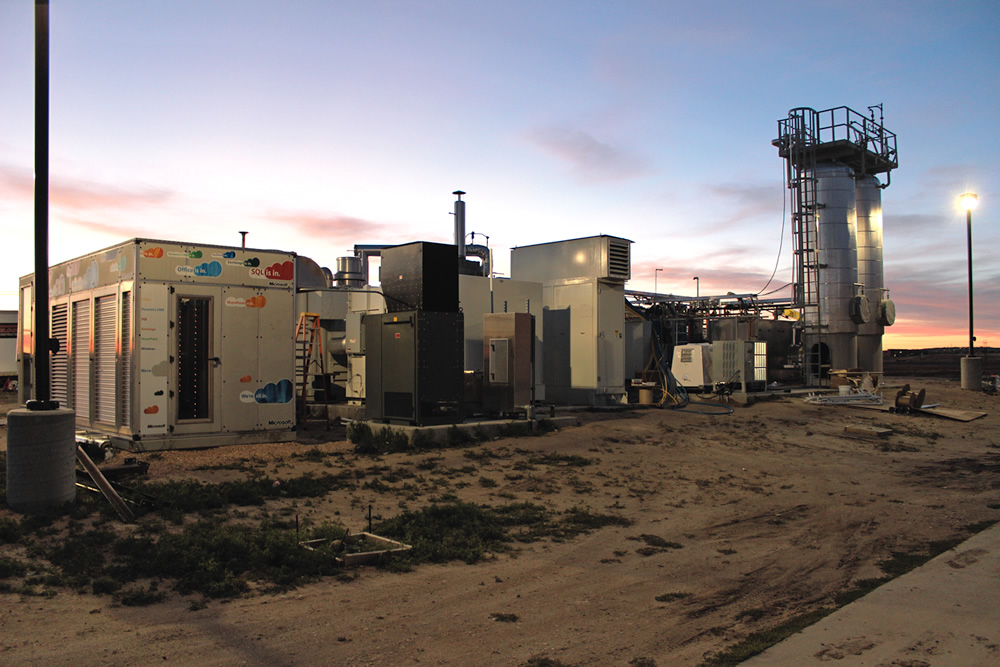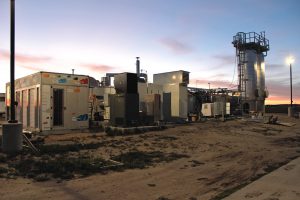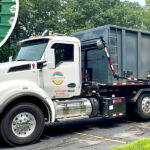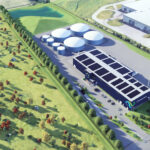BioCycle November 2014
Cheyenne, Wyoming: Biogas Powered Fuel Cell Supplies Microsoft Data Center
The dedication of Microsoft’s zero-carbon, waste-to-energy-powered Data Plant in early November highlighted the potential of anaerobic digester biogas as a 24/7 renewable energy source. The project uses biogas produced at the Dry Creek wastewater treatment facility in Cheyenne to power the fuel cell, supplied by FuelCell Energy, Inc., at the Data Plant. The fuel cell electrochemically converts the biogas into electricity to power the Microsoft IT server container. The fuel cell plant is expected to produce 300 kW of renewable power while the data center will only use about 200 kW. The remaining kilowatts will be delivered back to the wastewater treatment plant to reduce its electric bills. Siemens worked with Microsoft and FuelCell Energy to engineer and install power monitoring equipment for the data center to measure performance and energy output. The biogas-powered fuel cell provides base load power for continuous (24/7) electricity and heat and on-site power production, improving reliability without the cost of electrical transmission and distribution.
The State Loan and Investment Board approved a $1.5 million Wyoming Business Council Business Ready Community grant request from the city of Cheyenne in 2012 to help fund the $7.6 million plant. Microsoft covered the remaining cost. “Our objective is to transform the way our data centers do business, with greater energy efficacy and a lower environmental impact,” explained Christian Belady, General Manager of Microsoft’s Datacenter Services. “By bringing together the power plant with the data center, we are actually simplifying the power distribution infrastructure and improving efficiency in the distribution of power. We’re excited to explore such innovative renewable solutions that can help lead to a more sustainable future for everyone.” The fuel cell power plant began operating on clean natural gas in early 2014 and is now operating fully on renewable biogas. The Cheyenne project is being evaluated as a template for future potential megawatt-class data center applications utilizing renewable biogas.
Freiburg, Germany: Laser Technology Tracks Biogas Leaks
In 2013, the nearly 8,000 biogas plants in Germany produced a total of 26.42 tera-watt hours (TWh) of electricity, representing about 17 percent of the gross electricity generation from renewable energy in the country — and providing electricity to 7.5 million households. Leakage of even small quantities of biogas from these plants, e.g., from joints of the gas lines or fermenters, can result in fires and release of methane into the atmosphere. Recognizing the lack of an inexpensive and safe technology to enable operators to track down leaks in all system parts quickly, the German Federal Ministry of Food and Agriculture provided funds to researchers and a measuring equipment manufacturer to address the issue. The project team included the Fraunhofer Institute for Physical Measurement Techniques in Freiburg, the Fraunhofer Institute for Environmental, Safety and Energy Technology in Oberhausen and the measuring instrument manufacturer Schütz GmbH Messtechnik from Lahr.
According to the Fraunhofer Institute, the team developed a technology based on optical emission and backscattering spectroscopy. In the process, the light of a strong laser beam detects escaping methane. Simultaneously, the gas irradiates part of the light back. The scientists analyze this proportion and determine the gas concentration from the absorption spectrum of the escaping substance. Since the gas spectrum is very precise, only methane is very selectively measured. The optical portion of the measurement system (which includes the laser, detector, camera and range finder) is pointed at the equipment to be inspected. A connected tablet PC collects the data and evaluates it. The screen displays the graphically edited information concerning the escaping methane and the exact position of the leak. Measurements from up to 15 meters (almost 50 feet) are possible. The technology is expected to be commercially available within five years.














